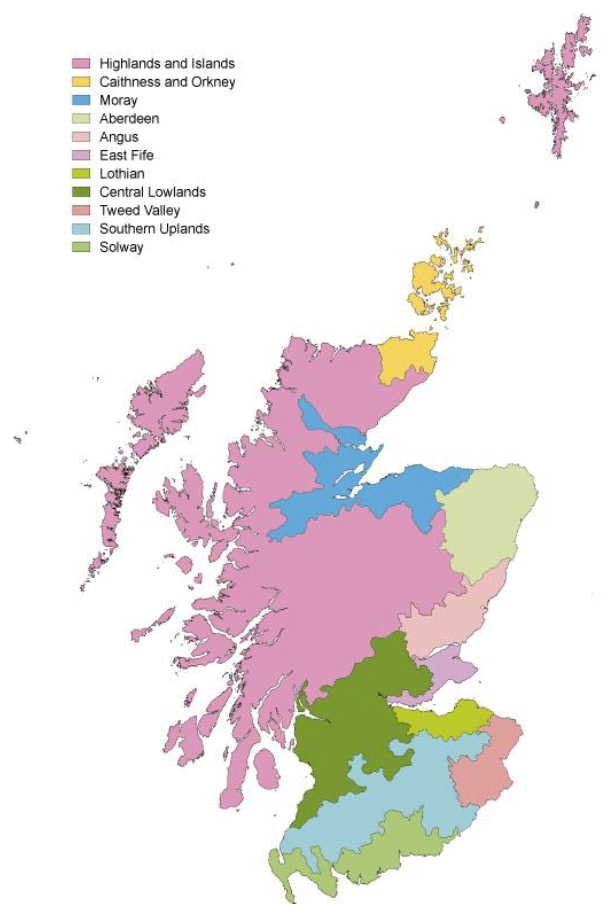Pesticide usage - arable crops and potato stores 2018: survey results
Information from a survey of pesticide use on arable crops and potato stores in Scotland during 2018.
This document is part of a collection
Appendix 4: Survey methodology
Sampling and data collection
Using the June 2018 Agricultural Census(13), a sample was drawn representing arable cultivation in Scotland. The country was divided into 11 land-use regions (Figure 31). Each sample was stratified by these land-use regions and according to holding size. The sampling fractions used within both regions and size groups were based on the areas of relevant crops grown rather than number of holdings, so that smaller holdings would not dominate the sample.
The survey covered pesticide applications to arable crops where all or the majority of the growing season was in 2018. As well as recording treatments applied directly to the crop, data was also collected on land preparation treatments prior to sowing or planting the crop.
Following an introductory letter and phone call, data were collected either by personal interview during a visit to the holding or during a phone interview or by email. Where necessary, information was also collected from agronomists and contractors. In total, information was collected from 315 holdings growing arable crops (Table 29). These holdings represent 8 per cent of the total crop area grown.
Raising factors
National pesticide use was estimated by ratio raising. This is a standard statistical technique for producing estimates from a sample. It is the same methodology used by the other UK survey teams and has been used for all historical datasets produced by the Pesticide Survey Unit, allowing comparability over time. The sample data were multiplied by raising factors (Tables 32). These factors were calculated by comparing the sampled area to the areas recorded in the Agricultural Census within each region and size group. An adjustment (Table 33) was made for each crop within each region by applying the raising factors to the sample area of each crop grown and comparing this with the census area. This adjustment modifies the estimate to take into account differences in composition of crops encountered in the sample and those present in the population. A second adjustment was necessary for some crops which were present in the population, but were not encountered in the sample in some strata.
Figure 31: Land use regions of Scotland(14)

Changes from previous years
There are a number of changes which should be noted when comparing the 2018 data with the previous survey.
The areas and weights treated with individual active substances are no longer included at crop level in this report. These data are now published separately as supplementary tables in Excel format to allow continued user access to the full dataset. In this report, the areas treated and weights of pesticide formulations (mixture of active substances in a product) by crop are presented in Tables 2-17 and summary active substance data are presented in Tables 19 to 27. The aim of this change is to focus on the key metrics at crop level and reduce the size of the published report. This approach is consistent with the output from the other UK pesticide survey teams.
The previous report contained information about grower adoption of Integrated Pest Management (IPM). IPM data was not collected during the 2018 survey. It is anticipated that IPM data will be collected and published every 4 years. This allows IPM uptake to be monitored over time but reduces the burden on, growers and surveyors.
It should also be noted that the total number of refusals to participate in this voluntary survey increased from 36 per cent in 2016 to 44 per cent in 2018. This has resulted in a 2018 sample ten per cent lower than target. However, this is an improvement on the 2016 sample that was 18 per cent below the desired size. This trend in decreased participation has been noted in our surveys in all crop sectors and it is possible that reduced sample size has influenced the estimates made in this report (please refer to appendix 5).
Data quality assurance
The dataset undergoes several validation processes as follows; (i) checking for any obvious errors upon data receipt (ii) checking and identifying inconsistencies with use and pesticide approval conditions once entered into the database (iii) 100 per cent checking of data held in the database against the raw data. Where inconsistencies are found these are checked against the records and with the grower if necessary. Additional quality assurance is provided by sending reports for review to members of the Working Party on Pesticide Usage Surveys and other agricultural experts. In addition, the Scottish pesticide survey unit is accredited to ISO 9001:2015. All survey related processes are documented in Standard Operating Procedures (SOPs) and our output is audited against these SOPs by internal auditors annually and by external auditors every three years.
Main sources of bias
The use of a random stratified sample is an appropriate survey methodology. A stratified random sample, grouped by farm size and region, is used to select holdings used in this survey. Sampling within size groups is based on area rather than numbers of holdings, so that smaller size groups are not over-represented in the sample. The pesticide survey may be subject to measurement bias as it is reliant on farmers/growers recording data accurately. As this survey is not compulsory it may also subject to non-response bias, as growers on certain farm/holding types may be more likely to respond to the survey than others. Reserve lists of holdings are held for each stratum to allow non-responding holdings to be replaced with similar holdings.
Experience indicates that stratified random sampling, including reserves, coupled with personal interview technique, delivers the highest quality data and minimises non-response bias.
Contact
Email: psu@sasa.gov.scot
There is a problem
Thanks for your feedback